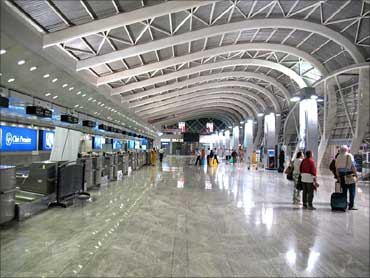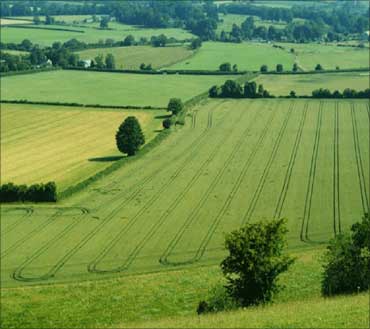
What was supposed to be Mumbai's answer to Delhi's swanky Terminal 3, is yet to get the necessary clearance from the concerned ministry. It's deadline was year 2012, and even in July 2010 no one knows if the project will ever see the daylight.
But Union Civil Aviation Minister Praful Patel has high hopes. In a recent press conference held in Pune he announced that he hoped to throw open the first phase of the Navi Mumbai airport by 2013. How, Mr Minister, can you set a deadline? Besides the environment clearance there are other problems too that is plaguing the project.
The new airport proposed over 2,000 hectares has been planned near Panvel, about 35 km away from the Mumbai airport.
The cost of the project, which is being developed through the public-private partnership route, was estimated at between Rs 3,200 crore (Rs 32 billion) and Rs 4,000 crore (Rs 40 billion). Though according to CIDCO, the total cost of the airport will be about Rs 9,970 crore (Rs 99.7 billion).
The airport will have a terminal area of 250,000 square meter and a cargo area of 100,000 square meter.
An environment impact assessment (EIA) study by the Indian Institute of Technology, Bombay has categorically said that there should not be any compromise as far as the ecology is concerned.
What are the issues that have delayed this project? Let's take a closer look...
Why does Mumbai need another airport? Click NEXT...

Why do we need a new airport near Mumbai?
Mumbai's Chhatrapati Shivaji airport will reach saturation point in passenger handling capacity -- of about 40 million -- in another two year's time.
Till 2007, Mumbai airport was the busiest in India. Now it has been surpassed by the Delhi airport.
The airport was expected to absorb annually 10 million passengers in its 'first operational year' 2012, doubling to 20 million by 2020 followed by 30 million passengers in 2025 and ultimately 40 million by 2030.
Click NEXT to read more...

Has land acquisition for the said project been completed?
Though (Praful) Patel said the City and Industrial Development Corporation of Maharashtra Ltd (Cidco) has completed 70 per cent of the land acquisition, the ground reality is not quite the same.
The land required is about 11.4 sqaure kilometre for the core airport activity and will have two parallel runways each 4,500 metres long.
Ten to twelve villages may have to be re-located, and the owners are not happy about the compensation they are being offered.
In a recent interview to NDTV Profit, Sashikant Kene, sarpanch of Wadgar gram panchayat said, they want Cidco to give them 500-square feet houses and market linked compensation for the agricultural land.
Instead, he complained, Cidco had given only Rs 15,000 for an acre. The whole issue of land acquisition is now being fought out in court.
The IIT-B study has called for implementation of a Rs 370-crore (Rs 3.7 billion) rehabilitation and resettlement (R&R) policy for 10 settlements in the airport zone.
The R&R policy envisages a one-time financial grant for construction of a house, freehold ownership with a concessional floor-space index, subsistance allowance for a year, reservation for jobs and allotment of preferential equity shares to project affected persons.
Click on NEXT to read more...

Why is the environment ministry NOT giving the necessary clearance?
Environmnet Minister Jairam Ramesh is fighting tooth and nail agianst this project. He said there are serious ecological issues that need to be addressed first.
Construction of the airport on the proposed site, said Ramesh, would destroy 400 acres of mangroves.
An area of 161.50 hectares has been found to be affected due to the airport project, based on a Satellite Remote Sensing Study.
Double that area of mangroves need to be planted in accordance to the order of the Bombay high court. Accordingly, 350 hectares has been identified for plantation of mangroves at Dahanu taluka of Thane district.
Click on NEXT to read more...

Two rivers need to be diverted
The IIT study concluded that the development of the airport without diverting the Ulwe river and training of the Gadhi river is not technically feasible and viable, as this option cost about Rs 16,000 crore (Rs 160 billion) and defeats the very purpose of retaining the geomorphology of rivers and its aquatic life and mangroves.
Environmental lawyer Girish Raut told The Asian Age that changing the course of the two rivers would be a 'blunder'.
The same mistake, he said, was committed while constructing the Mumbai airport. The Mithi river was diverted at two points and that "led to Mumbai getting flooded in 2005'.
Click on NEXT to read more...

CRZ issues
Ramesh also expressed concerns that building the airport at the present selected site would require the levelling of an 80-metre-high hill which raises significant coastal zone management issues.
The notification by the ministry of environment and forests say that the CRZ or coastal region zone is a boundary line from the high tide line up to a level of 500 metres which is in the landward side. This can also be an area below the low tide line and the high tide line.
The ministry had initially ruled out the construction of the airport since 25 per cent of the designated area is under the CRZ. And under this provision no commercial construction should be allowed.
But, later, it was decided by the environment ministry that Mumbai should be given a special status because of its development needs.
Environmentalists warn that the new airport would be vulnerable to high tides and sea storms even after land is reclaimed. The safe height to which the ground level has to be raised is four metres but Cidco will succeed in raising the level by just two-and-a-half to three metres. This would be risky as the potential height of sea waves is between three and 10 metres.
The status now:
The matter will come for consideration with the Environmental Appraisal Committee on July 21-22 and only then will its fate will be decided.